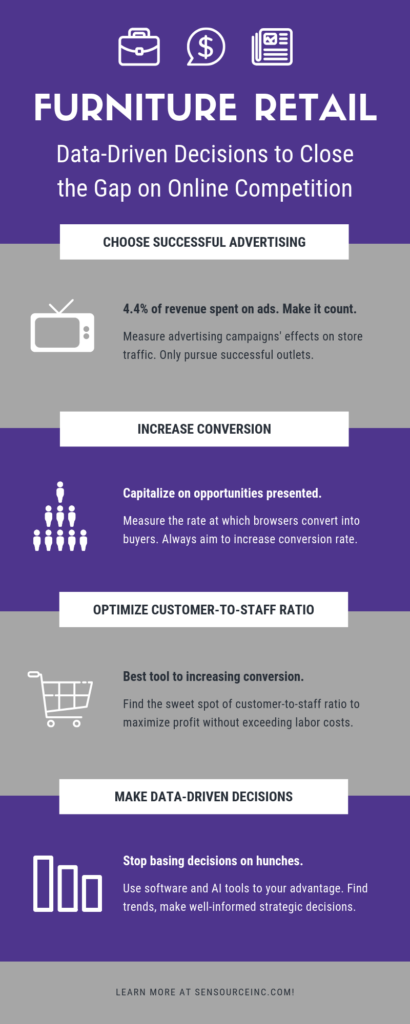Set apart from other retail sectors, furniture retail technology offers solutions unique to furniture and home goods stores.
While it may seem like a basic concept, monitoring how many people enter your furniture store is the foundation for key metrics that can improve store performance. The competition between online and physical furniture retailers is growing and store traffic is one metric that will help close the gap.
Physical store retailers need to start thinking like their online-competitors in terms of data-based decisions. Online retailers know exactly how many people visited their website from each digital marketing campaign; how visitors engage with their “store”; and details on their path to purchase. These metrics can then be used to refine strategies and continually improve efforts. Data for physical stores can be used in much the same way.
Advertising
Amongst small and medium retailers, furniture and jewelry stores have the highest advertising spend. Furniture retailers spend on average 4.44% of revenue on advertising. According to Libby Bierman, Analyst at Sageworks, “Within retail, privately held furniture stores and jewelry stores with less than $10M in annual revenue invest more than 4 percent of revenue back into advertising. It may be that these firms see advertising as a critical driver of foot traffic, a big arbiter of their success.”¹.
If the objective of spending 4.44% of revenue on advertising is to increase foot traffic, how do you measure its success? You measure advertising success by measuring foot traffic.
For example, find a baseline for your store traffic. When your radio ad airs, measure its effect. Did it successfully drive more traffic to your store? If not, consider alternative advertising methods. Stop throwing money at advertising campaigns that aren’t successful. Your online competitors wouldn’t continue ads that didn’t drive traffic to their website.
Conversion
Measuring store traffic will not only tell you the performance of advertising campaigns, it’s also the foundation of measuring conversion. Conversion rate is a golden metric for retailers. It answers questions such as: at what rate are browsers converting into customers? And how effective is your sales team at capitalizing on the opportunities presented? It gives an apples-to-apples comparison of store performance amongst a chain of locations.
The biggest advantage physical stores have over online furniture retailers is the customer experience. Customers can explore with their senses, converse with a sales person, and make an emotional connection to your brand. An online retailer’s efforts to pop-up a chat window at the opportune time just can’t compete with the in-store experience you can offer. Therefore, it’s critical to measure in-store experience by keeping close watch on conversion rate. Continually improve sales tactics, inventory, store layout, and all factors that contribute to increasing conversion.
Customer-to-Staff Ratio
Lastly, measuring store traffic enables furniture retailers to gauge and optimize customer-to-staff ratio. Your sales staff is your best tool to increasing conversion rate, and also one of your highest costs, so it’s crucial to get it right. Too little staff means visitors are left without help and not converting into customers; too much staff means excess expense. Schedule staff hours based on peak traffic times of the day and days of the week. With high-dollar purchases, a lower customer-to-staff ratio is ideal as sales staff needs to be available to explain products, answer questions and engage with customers.
SenSource’s Vea reporting platform actually has a built-in staff hour optimization feature. The algorithm finds the sweet spot of staff hours to customers based on predicted traffic, conversion rate, and average sale value. It finds optimum staff hours at which conversion is the highest while still maximizing profit.
Furniture Retail Technology for Data-Based Decisions
In the ever-changing face of retail, monitoring store traffic is one way furniture retailers will remain relevant and compete head-to-head with online retail competitors. Transitioning your business strategy to base decisions on data rather than hunch is key. With technology advancements, including AI, making sense of data is easier than ever before. Using software tools to find trends and make accurate predictions levels the playing field – you don’t have to be a data analyst to understand the information, make key decisions, and put it into action.
Why wait? Start monitoring store traffic now. Contact us to get started.
¹As quoted in Small Business Trends article, “How Much Do Small Businesses Spend on Advertising and Marketing?” 4/24/18

